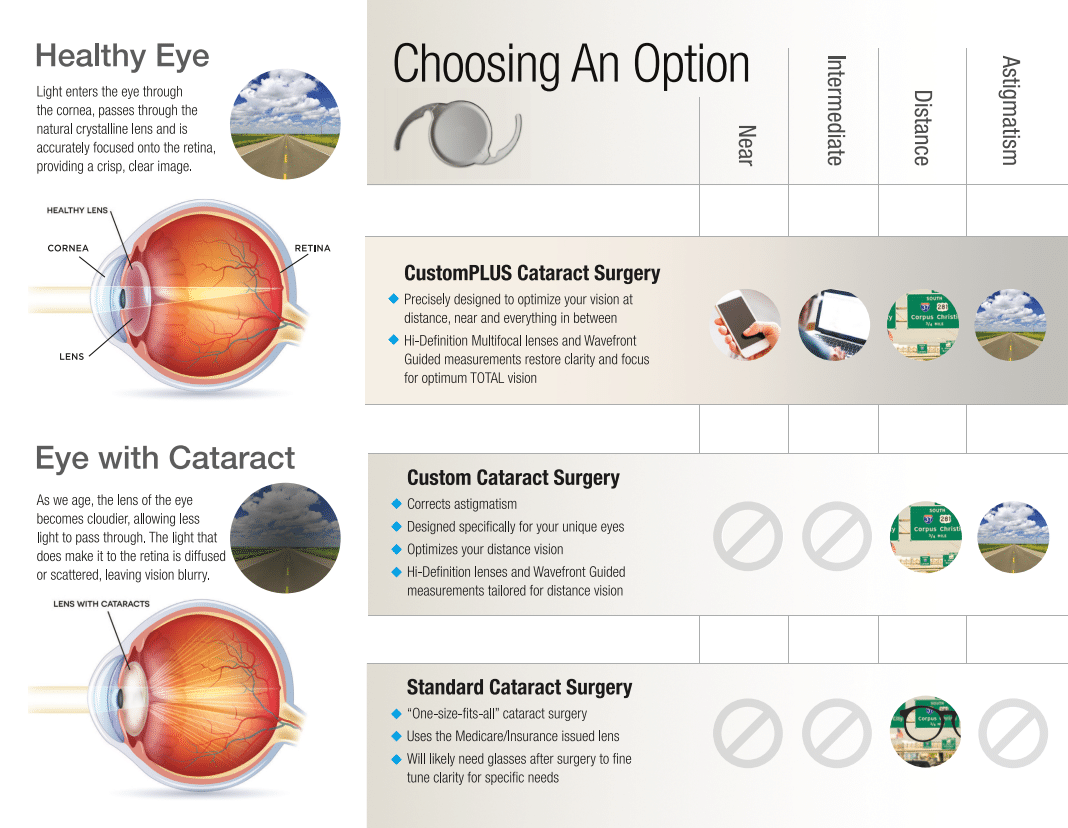A cataract is a progressive clouding of the natural lens in your eye. If symptoms of cataracts are mild, a change in glasses may be all that is necessary. However, if cataracts are causing symptoms that interfere with daily activities, surgery may be considered. People with advanced cataracts often say they feel as if they’re looking through a light fog or a piece of waxed paper.
No medication, laser treatment or exercise regimen can make a cataract disappear. The only way to eliminate a cataract is through cataract surgery, a 10-minute microsurgical procedure in which the old clouded lens is removed through a tiny sutureless incision and replaced with a permanent clear plastic intraocular lens (IOL). The exact power of the new, implanted lens is determined ahead of time by a precise measurement of the eye.
Cataract Surgery Options
At Eye Associates, we have three surgical treatment options available to you: Standard, Custom, and CustomPLUS. All of these are available Dropless and IV Free. The Standard option includes a standard monofocal IOL which is covered by your insurance as part of your cataract surgery. Patients that want more freedom from glasses and contacts have the option to choose Custom or CustomPLUS packages which incorporate laser guided measurements and elective premium IOLs. Both the Custom and CustomPLUS packages include correction for astigmatism, if needed. The right choice for you depends on your personal preferences, lifestyle, and the overall health of your eyes. Prior to your procedure and after the evaluations necessary, the surgeon will decide which option will work best for you.

About Eye Associates SurgiCenter
At Eye Associates, our cataract surgeons combine the use of a small incision, “Dropless IV Free” technique that can be performed in our comfortable, convenient and close to home AAAHC, Medicare and State of New Jersey certified ambulatory surgery center in Vineland. The entire process usually requires only two hours of your time from start to finish. The actual surgical procedure is painless and takes less than 15 minutes. Our nurses and staff are present to help us with your actual surgery as well as to assist you and make your experience pleasant.
Our SurgiCenter in Vineland is accredited by the Accreditation Association for Ambulatory Health Care (AAAHC), the nation’s leading accrediting organization of outpatient facilities. The Eye Associates SurgiCenter being AAAHC accredited means that we have undergone a rigorous professional scrutiny by highly qualified AAAHC professionals and been found to provide quality care.
How is Cataract Surgery Performed?
For those interested in seeing live surgery, please click on this link. Disclaimer: This video contains live surgery which may not be appropriate for all audiences.
Removing the Cataract
The surgery is done under a microscope using tiny instruments the size of a pen tip. The eye is numbed with anesthetic drops. A very small incision is created in the cornea and highly advanced ultrasound device is used to break the cataract up and remove it in tiny pieces.

Placing the IOL
After the cataract is removed, an artificial lens (or IOL) is put in its place. IOLs are made of flexible material allowing our surgeons to insert the lens through tiny incisions. Once inserted, the lens opens up and locks in place.
Closing Up
Once the cloudy cataract is removed and the artificial lens is inserted, light can now easily pass through the lens restoring vision. The incisions are so small that stitches are rarely required.
Will I Experience Any Pain?
Do I Have To Wait for My Cataract To Be “Ripe” Before Surgery?
What Are the Risks of Cataract Surgery?
A complete review and discussion of your risks will be provided and it is important to discuss any questions with your cataract surgeon before surgery. Any surgery can result in problems that can leave you with the same or worsened vision. In general, the chance of problems is probably around 4-5%. This means that 95% of patients have some (or a lot of) vision improvement. Cataract Surgery, like any surgical procedure, carries with it the potential for risks and complications. Though rare, the possible risks of surgery include: bleeding, postoperative infection, severe corneal edema, retinal detachment, permanent dilation of the pupil, and even loss of vision. Other complications include the development of astigmatism and drooping of the upper eyelid, both of which are treatable. Cataract Surgery is a common procedure and we make every effort to minimize the chance for any problems to occur during or after surgery. Please read our Cataract Consent Form for a complete list of risks.
How Soon Can I Get Back to My Regular Activities?
Does A Cataract Come Back?
Cataract Surgery Options
At Eye Associates, we have three surgical treatment options available to you: Standard, Custom, and CustomPLUS. All of these are available Dropless and IV Free. The Standard option includes a standard monofocal IOL which is covered by your insurance as part of your cataract surgery. Patients that want more freedom from glasses and contacts have the option to choose Custom or CustomPLUS packages which incorporate laser guided measurements and elective premium IOLs. Both the Custom and CustomPLUS packages include correction for astigmatism, if needed. The right choice for you depends on your personal preferences, lifestyle, and the overall health of your eyes. Prior to your procedure and after the evaluations necessary, the surgeon will decide which option will work best for you.

About Eye Associates SurgiCenter
At Eye Associates, our cataract surgeons combine the use of a small incision, “Dropless IV Free” technique that can be performed in our comfortable, convenient and close to home AAAHC, Medicare and State of New Jersey certified ambulatory surgery center in Vineland. The entire process usually requires only two hours of your time from start to finish. The actual surgical procedure is painless and takes less than 15 minutes. Our nurses and staff are present to help us with your actual surgery as well as to assist you and make your experience pleasant.
Our SurgiCenter in Vineland is accredited by the Accreditation Association for Ambulatory Health Care (AAAHC), the nation’s leading accrediting organization of outpatient facilities. The Eye Associates SurgiCenter being AAAHC accredited means that we have undergone a rigorous professional scrutiny by highly qualified AAAHC professionals and been found to provide quality care.
How is Cataract Surgery Performed?
For those interested in seeing live surgery, please click on this link. Disclaimer: This video contains live surgery which may not be appropriate for all audiences.
Removing the Cataract
The surgery is done under a microscope using tiny instruments the size of a pen tip. The eye is numbed with anesthetic drops. A very small incision is created in the cornea and highly advanced ultrasound device is used to break the cataract up and remove it in tiny pieces.

Placing the IOL
After the cataract is removed, an artificial lens (or IOL) is put in its place. IOLs are made of flexible material allowing our surgeons to insert the lens through tiny incisions. Once inserted, the lens opens up and locks in place.
Closing Up
Once the cloudy cataract is removed and the artificial lens is inserted, light can now easily pass through the lens restoring vision. The incisions are so small that stitches are rarely required.
Will I Experience Any Pain?
Do I Have To Wait for My Cataract To Be “Ripe” Before Surgery?
What Are the Risks of Cataract Surgery?
A complete review and discussion of your risks will be provided and it is important to discuss any questions with your cataract surgeon before surgery. Any surgery can result in problems that can leave you with the same or worsened vision. In general, the chance of problems is probably around 4-5%. This means that 95% of patients have some (or a lot of) vision improvement. Cataract Surgery, like any surgical procedure, carries with it the potential for risks and complications. Though rare, the possible risks of surgery include: bleeding, postoperative infection, severe corneal edema, retinal detachment, permanent dilation of the pupil, and even loss of vision. Other complications include the development of astigmatism and drooping of the upper eyelid, both of which are treatable. Cataract Surgery is a common procedure and we make every effort to minimize the chance for any problems to occur during or after surgery. Please read our Cataract Consent Form for a complete list of risks.
How Soon Can I Get Back to My Regular Activities?
Does A Cataract Come Back?

